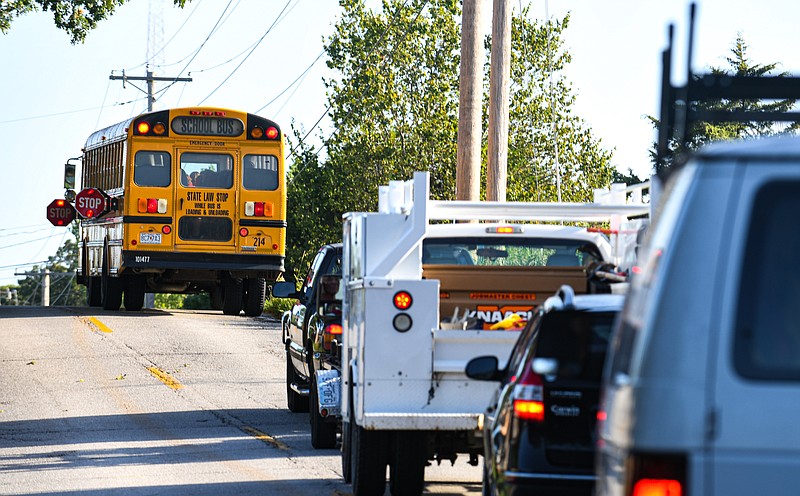The year 2022 was a landmark year for school funding as Missouri Gov. Mike Parson signed off on a budget to fully fund the K-12 Foundation Formula, provide nearly $22 million to increase educator base pay, and offer over $328 million to cover school transportation costs.
That $328 million means that for the first time since 1991, the state government took on its full share of school transportation costs, 75 percent, potentially leaving schools with money to spend in other areas, including the classroom.
Costs
The timing, too, is favorable: transportation posed a headache for school districts this year -- diesel fuel prices skyrocketed as many districts continued to face bus driver shortages.
Jeff Jennewein, the new superintendent of Cole County R-1 School District in Russellville, said he has seen increases in costs in his day-to-day life, including fuel, paper towels, soap and food, to name a few. Those same costs are affecting school districts.
Jefferson City School District has been seeing higher gas prices as well.
"It really helps district's budgets, particularly now that fuel costs are increasing and going up. That's a major expense when we look at the transportation costs, so we were excited that the Legislature looked at that seriously and looked at what districts were having to expend for transportation costs and put that funding in for us," said Jefferson City Chief Financial Officer Shari LePage.
LePage said the district has planned for a 5 percent increase in overall costs with its 2023 bus contract.
The district does pay for its own gas, so it absorbs the cost of fuel price increases.
Cole County R-1 owns five school buses and contracts with Durham School Services to run six routes daily, not including extracurricular or other trips, Jennewein said. He said four out of five of those buses are in good condition, and he's planning to look into the other bus.
Jefferson City School District contracts with First Student, and the average age of the bus fleet it uses is six years. The district runs 64 routes, and it purchases 7,500 gallons of diesel every two weeks to keep its buses running.
Superintendent Charley Burch said Cole County R-5 in Eugene runs eight routes. It owns one 2005 bus and contracts with Durham for a fleet with an average age of nine years. The district's maximum age requirement is 12 years.
What does the windfall mean?
The state government has allocated $328.4 million to help cover the costs of school transportation.
"Any time funding increases, it's a really good thing. It's a good thing for schools, and it's a good thing for the people that work in them or that learn in them, so it's never a bad thing to increase funding," Jennewein said.
Since he is new to the district, Jennewein said the allocation of funds, including those saved by increased state funding for transportation, was overseen by the previous superintendent and board of education, and he has confidence in their choices.
"So really my job this year is just to ensure that the funds that he allocated are done with fidelity," Jennewein said.
Acting Superintendent Chris Marshall at Blair Oaks said under the new allocation, the district could be looking at $300,000 in revenue for transportation.
Jefferson City's LePage said, "For us, it's very exciting that the Legislature looked at that as a need and funded it. Districts for a long time have been having to use their local funds to pay transportation costs that by statute are supposed to be paid for by the state, so we were excited to see that they were interested in funding that."
The statute LePage referenced states school districts can receive up to 75 percent of the cost of pupil transportation services from the state.
In the last decade, the actual number has been around 25-40 percent, LePage said.
"If this is going to become a consistent revenue source from the state, it will allow those local funds that are freed up to be used for more instructional materials and that type of stuff within the classroom. We wouldn't want to necessarily do that initially because we're a little concerned about the consistency of the funding," said LePage. "We'll have to kind of see how that goes, and if it's not going to be a consistent source of funding, we wouldn't want to fund anything that would be an ongoing cost. We may look at more one-time expenses, but if we see that it is going to become more of a consistent revenue source from the state going forward, then we could look at some more long-term consistent expense reimbursement with that."
Burch added: "Obviously anytime you get something fully funded that hasn't traditionally been fully funded, that's good for the district, so it definitely helps our budget in terms of operational finances, so it will allow us obviously to use more of our operating monies to address other needs in our district."
He said that money could go toward classroom supplies and training for teachers or daily operations, such as utilities.
The Environmental Protection Agency has announced it will offer grants for school districts to switch to zero-emission buses, which it says are less costly to operate than diesel buses and also offer cleaner air for student and community health.
When asked about a possible switch to zero-emission buses, many were open to the possibility, including Durham School Services, which operates buses for Russellville and Eugene.
"We would never close the door on anything like that," Jennewein said. He said he'd like to look into the possibility further.

